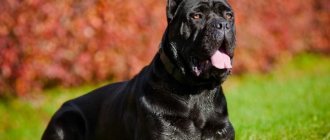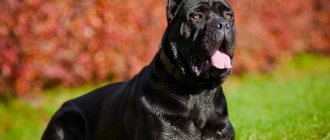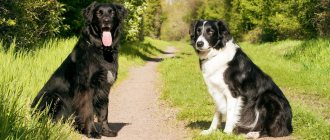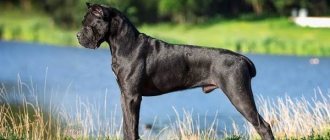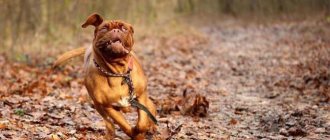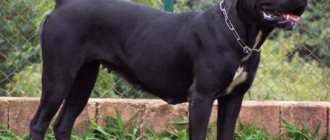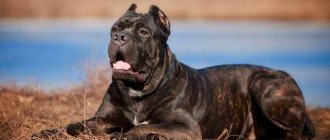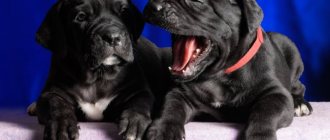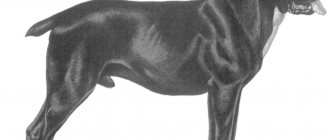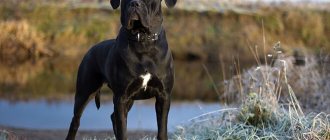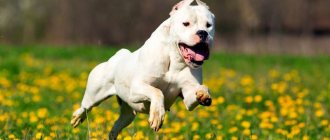Characteristics and description of the breed
A combination of power and elegance - this is how these mighty beauties can be briefly described. What epithets were given to them: brave, like a Corso; descendant of gladiator dogs; a reliable bodyguard and a loyal friend.
Aggressiveness
They are not evil by nature. But outsiders are viewed with caution. Attacks only when commanded by its owner or in response to hostility. Males are pugnacious during puberty. A healthy dog does not show unreasonable conflict. Build connections like this: you are the boss, the leader, and your four-legged friend obeys. Your word is law!
Activity
Require daily physical and intellectual activity. If there is insufficient activity, they will begin to dominate, this is a serious test for the owner. Puppies need early socialization. Despite their outward solidity, they will not refuse to play or jog.
Training
It is advisable to go through a general training course (general training course) with your puppy. Early socialization is encouraged. At 8-9 months you can take the “Dog in the City” course.
Shedding
Corsas shed their hair twice a year. During this period, comb the coat daily with a rubberized mitten, removing dead hair.
Need for care
No special care is required. You need to monitor the condition of the coat, periodically wipe the eyes and ears, trim the nails once every two weeks, feed well and take long walks.
View this post on Instagram
Posted by Christina (@tiksya) Nov 19, 2022 at 7:11 PST
Friendliness and attitude towards children
A nanny dog is about a Cane Corso. Genetics tells us to protect those who are weaker. The child is always under strict control; the Corsica will never intentionally offend the baby and will tolerate his pranks. Explain to children that animals should be treated kindly and respectfully.
Health
Health is good if there are no genetic diseases.
In the first year of life, two sets of vaccinations are necessary. In subsequent years - one complex at a time.
Before vaccination, the animal must be dewormed. Drugs are given strictly by weight, consult your veterinarian.
Treat your pet for ticks and fleas every spring. There are drops, there are tablets - the choice is yours.
Attitude towards loneliness
Corsovs cannot be left unattended for long. Separation from the owner is painful, they refuse to eat and can even die. He will not survive the betrayal of his man.
Try not to leave your puppy or teenager alone for long periods of time. If he gets bored, he will entertain himself with chewing. They chew everything: furniture, wires, telephones, passports, linoleum. Buy more toys and stringy bones so that you have something to do in your absence.
Maintenance cost
Expensive, expensive, and again expensive. It will cost 7-8 thousand per month for food. Add to this unforeseen expenses for veterinary care, vaccinations once a year, equipment for walks, toys, treats, classes with a dog handler.
Intelligence
Many owners note very high intelligence. Kors understands everything, as a person, is a wonderful companion, loves to do everything together with his owner.
Noise
Not prone to unreasonable barking, neighbors will not complain. He behaves calmly in the apartment.
Security qualities
The cors carefully guards its habitat. This property is inherent at the genetic level, even without special training. He clearly divides people and animals into two categories: his own and others.
Lifespan
The main disadvantage of the breed is that they live a short life, only 10-12 years.
Lifespan
On average, dogs of this breed live 10-11 years.
IMPORTANT!
If you monitor your dog's health and regularly visit the veterinary clinic, he can live up to 14 years.
The main conditions affecting the life expectancy of an animal are:
- Cane Corsa physical activity, frequent walks with active games;
- proper nutrition, complete and enriched with vitamins and minerals;
- timely elimination of illnesses and injuries.
The price of a puppy, how to choose it when buying?
Before you think about buying a puppy, choose the direction in which it will go in the future. Will the dog participate in exhibitions, sporting events, or simply please the eye and enjoy communication with its owners? Accordingly, they are already starting from this.
You should buy a baby when he is at least 8 weeks old and feeding on his own. Its weight should be 8-9 kg. Vaccinations for puppies must be completed and noted in the passport. Next, external data according to the standard is determined.
You should request in advance to provide the parents’ pedigree and inquire about all their genetic diseases. The higher the title of the mother and father, the higher the price for the puppy.
The cost of a good pet in elite nurseries ranges from $300 to $2000. Dogs with a bad pedigree, with unclean blood or that do not meet the standards are sold several times cheaper than usual.
Prices
Cane Corso, the price of which depends on the geographical location of the kennel, the age of the puppy and other factors, is expensive in Russia. It is worth cautioning that high-quality Cane Corsos are not sold at poultry markets. There are not many representatives of the breed in the country yet, so nurseries control “unauthorized” breeding and stamping of Corso puppies.
Even in the capital there are not many nurseries; you can count them on one hand. Those who want to adopt this unique breed sign up in advance in the queue. The cost of elite puppies (Cane Corso is one of these) can exceed the level of 60 thousand rubles. On average in Russia, the future owner pays 20-3 thousand rubles for a puppy.
On a Cane Corso, the price also depends on belonging to a particular class:
- Pet-class puppies, which are distinguished by good health and minor deviations from the standard, cost from 25 to 30 thousand rubles. They will not be able to participate in exhibitions and win awards, but they will become best friends.
- Breed-class puppies, which are used for breeding, cost from 30 to 45 thousand rubles.
- Show-class puppies - offspring from titled parents and future champions - will cost the future owner from 45 to 60 thousand rubles.
Story
Descendants of Roman gladiator dogs are the pride of Italy. The ancestors of modern Corsi dogs are considered to be Tibetan Great Danes. In antiquity, they were involved in hunting, as guards in military campaigns, as baiting dogs in battles with bears and lions. Later, the breed was crossed with Celtic greyhounds and the duties changed: they took care of livestock and farmland.
On a note! In the Roman Empire, these warriors did not differ in cost from a thoroughbred horse, since with appropriate training they replaced a trained fighter in battle.
Because of the wars, these giants practically became extinct; there were very few purebred representatives left. The caring Italian Giovanni Bonatti Nizzoli, together with his associates, found them throughout the country and engaged in breeding to preserve the species. In 1887, a standard was determined that outlined the distinctive features of the Cane Corso. In 1994, the breed received breeding rights. In 1996, the breed male won the international exhibition. Since then the numbers began to grow.
Puppies
Cane Corse puppies are very expensive, and at first glance it may seem that their maintenance also requires fabulous money. In reality, this requires the same amount of money as keeping a Rottweiler, German Shepherd, Boxer or large mongrel dog.
From the first day the little “Italian” appears in the house, he needs attentive attention:
- A place for the puppy to rest is equipped in a part of the house or apartment where there are no drafts, close proximity to heating devices and high traffic. The presence of an elastic mattress (preferably with a removable cover to maintain cleanliness) is mandatory, let it be larger than the size of the puppy, because the pet will very quickly increase in size.
- The puppy is prohibited from walking on stairs or jumping over obstacles, as this can lead to improper development of the still immature musculoskeletal system. To avoid the same problems, the puppy is not picked up by the chest or front legs, but with one hand under the chest and the other under the stomach.
- Cane Corse, whose puppies do not yet have immunity, should not be taken out for walks from the first days. The optimal time for the first walk is the third week after the 2nd vaccination.
- If you go out with the puppy after feeding or sleeping, she will gradually learn to do her “toilet” chores outside.
- The age of 1.5-2 months is the right time to start accustoming to a nickname and collar. We do not recommend putting the collar over the ears, or stroking the head and ears, as this can cause the ears to be positioned incorrectly.
The fear of owning a Cane Corse is due to the relative youth of the breed. Dogs were first brought into Russia only in 1994. Very often, the fears of future Italian owners are not justified, since their puppies are easy to train. The Corso is even called a “dog for amateurs”; with a serious approach, even a person who is dealing with dogs for the first time can raise and train it.
If you instill good habits in your puppy from the first days and raise it correctly, you can get an adequate protector, a loyal friend, an uncompromising guard who will be the pride of the owner not only due to his presentable appearance and excellent character.
Appearance
Very large in size and terrifying in appearance. Males reach a weight of 45-50 kg with a height of 64-68 cm, females weigh 40-45 kg with a height of 60-64 cm. An athletic build, broad shoulders, a full-bodied muzzle, and a graceful gait reveal the genetics of the Molossian Great Dane. The body format is stretched.
Head
Large and massive. The muzzle is voluminous, square in shape. Jowls should not be too saggy.
Eyes
Widely spaced, rounded, dark iris color preferred (black or brown).
Ears
Fit tightly to the head, medium in size, widely spaced. The ends taper and fit close to the cheeks. When docked, it is given a triangular shape and looks more menacing.
View this post on Instagram
Posted by Yulia's Dogs (FCI Kennel) (@yulias_dogs) Nov 20, 2020 at 8:14 am PST
Jaws
The jaws are powerful and can easily handle the tibia of cattle. The lower one protrudes slightly forward.
Torso
Longer than the height at the withers, the body is dense, the croup is slightly sloping. Developed chest bone. The back is muscular. The ribs should not protrude.
Neck
Strong, powerful, muscular. The same size as the head.
Tail
Massive, long from birth, but it can be docked.
Paws
The limbs are oval, the fingers are gathered into a ball, the pads are elastic, the claws are strong.
Wool
Short, shiny, dense, close-lying, sparse undercoat.
Color
Mostly black (considered the standard), brindle, light red. Less commonly, gray, slate, fawn. There may be white spots on the chest, paws in “socks”.
Note! Individuals of brindle and red color with a mask up to the eyes.
Theses
- They are a working dog and today they are often used as guard dogs.
- This dog needs physical and mental activity.
- This is a dominant breed that tries to lead the pack.
- Not recommended for those who have decided to get a dog for the first time, as they are dominant and domineering.
- This is one of the healthiest breeds among large dogs.
- They are aggressive towards other dogs and animals.
Vaccinations
Mother's milk, which puppies are fed in the first weeks after birth, provides their immunity. When the lactation period ends, the babies' protection from infections and diseases disappears. It is replaced by immunity independently developed by the puppies.
| Age | Graft |
| 6-8 weeks | Vaccine against enteritis and hepatitis |
| 8-10 weeks | Revaccination + vaccinations against parvovirus, adenovirus and parainfluenza |
| 2.5-3 months | Vaccination against plague |
| 6-8 months | Rabies vaccine (if a plague vaccination was previously given, rabies vaccination is carried out only at 8 months) |
| 7-8 months | Repeated vaccination against plague |
| 1 year | Vaccination against leptospirosis |
| In the future, vaccinations are repeated annually at the same time. | |
Popular drugs for vaccination are Eurican, Duramune, Nobivac.
Vaccination is not a method of treating a disease, but its causative agent, so it is important that the puppy is absolutely healthy at the time of vaccination.
Nicknames for boys and girls: what to call them?
When assigning a nickname to a dog, owners are guided by different principles. For example, some are based on the Italian origin of the breed, others take a closer look at the pet, its character and only then give it a nickname. Assigning a nickname is a responsible matter. It is necessary to choose a nickname that will be easy to pronounce and memorable for all family members.
Names for boys:
- Octavian;
- Tiberius;
- Gideon;
- Gilmore;
- August;
- Mussius;
- John;
- Mark;
- Oscar;
- Hart;
- Baron;
- Elf;
- Otis;
- Sam;
- Cleve.
Names for girls:
- Molly;
- Lucky;
- Rhonda;
- Callie;
- Cessa;
- Indus;
- Adela;
- Gloria;
- Betty;
- Karin;
- Lady;
- Honda;
- Shaylee;
- Nellie;
- Melissa.
Maintenance and care
Despite the impressive dimensions, they are suitable for an apartment. The ideal option is a private house with a large garden area where the dog can run around to his heart’s content. It is not advisable to place them in an enclosure: short fur does not keep them warm, they freeze outside, but they are Italians! And even more so, it is unacceptable to keep a Corsa in a kennel on a chain: constant presence next to the owner is necessary for a cane.
Nutrition
They eat a lot. Nutrition should be balanced, with plenty of protein. If you decide to feed dry food, choose premium or holistic. With a natural diet, the basis of the diet is meat and offal. As for foods, do not give pork, long bones, smoked meats, river fish, fatty sour cream, millet and pearl barley porridge, and sweets.
Be sure to give vitamins, calcium, the dog is heavy, additional minerals are needed for bone formation.
Feed 2 times a day. Make sure there is always fresh water.
Hygiene
The main problem is drooling. Keep a towel handy at all times.
Short hair does not require special care; bathe once every six months. It is recommended to use dry shampoo once a month.
To clean your ears, use a cotton pad and periodically wipe the earwax off.
Special bones clean your teeth. If tartar forms, contact your veterinarian.
Wipe your eyes regularly with a disc soaked in chamomile infusion.
Lubricate the paw pads with vegetable oil to avoid cracking. After a walk, paws should be washed, as the streets are sprinkled with reagents that are harmful to the skin. Due to the weight of Corsas, their paws often get cut; keep an eye on their condition and use special wax for their paws.
Health and illness
Like any large breed, Cane Corso is susceptible to joint diseases. Unfortunately, femoral dysplasia occurs in 30%. The disease has no cure and can manifest itself both in puppyhood and in middle age (after 5 years). Until the age of two, until the bones become stronger, you should not run or jump a lot. If you live in a house with stairs, take your puppy for walks in your arms for at least five months.
Another ailment common among these giants is allergies. The sooner you find out why, the better.
In third place are diseases of the eyelids (for example, an inverted eyelid). Only surgery will help.
To reduce the risks, undergo a veterinary examination every year, and in adulthood - every six months.
Mating
Breeding purebred puppies requires the fulfillment of a certain number of conditions.
Both parents have documents issued by RKF.
You need to participate in exhibitions.
The male and female must be the same color and similar build.
Puberty occurs at about one and a half years; in Europe, knitting can be done after 20 months. By this age, the dog can give birth to healthy offspring. Mating occurs on the 10th day of estrus. It is advisable to invite a specialist to monitor the process.
On a note! The female's pregnancy lasts 2 months.
Walks
You need to walk for a long time so that the dog spends energy and does not destroy the house.
Remember! A dog that is kind to its owner may perceive other people as a potential danger. Therefore, walk strictly on a leash and with a muzzle.
How to feed?
The dog of this breed is very active, it loves outdoor games. Therefore, to replenish lost energy, she needs a complete, balanced and fortified diet.
Until the age of five months, puppies are fed up to 6 times a day. After this, feeding is divided into three doses.
Immediately develop an hourly feeding schedule for the puppies. To prevent your dog from hunching his back while eating, you should place the dishes on a height at chest level.
As the puppy grows up, it becomes accustomed to the diet and later, when it becomes an adult dog, problems with eating will no longer arise.
If your dog's diet is based on natural products, then the diet needs to be varied. Protein comes from meat, fish, milk and poultry. For small puppies, the meat should be ground. But it’s better not to use minced meat.
The following products will be useful:
- boiled chicken;
- raw beef;
- rabbit, boned;
- blood.
Vegetables, fruits and dairy products should also be present in the Cane Corso's diet.
If you don’t have time to prepare natural food for your pet, you can replace it with equally fortified dry food. The veterinarian selects him.
Interesting facts about the Cane Corso
This breed of dog has existed for several thousand years, and during this time many interesting and sometimes surprising facts have accumulated about it.
For example, it is still unknown where the name of the breed “Cane Corso” came from. According to one version, this phrase comes from “Canum ex Corsica”, which means “dog from Corsica”. According to another version, the name of the breed comes from the Latin word “cohors”, which means guard.
In addition, the following interesting facts can be highlighted:
- The dog has very strong dominant traits. Once in a family, the dog will try to seize leadership in it, and if you indulge the puppy, he will feel like the leader of the pack. Therefore, beginners are not recommended to get a dog of this breed, since it is not easy to cope with it on their own;
- The Cane Corso has a very strong guard instinct. By one year, the dog will protect not only family members and property, but even other animals. It is not uncommon for Italian mastiffs to not let cats go outside, thwarting all their attempts to get out of the house;
- Cane Corso dogs are very popular in films. They have repeatedly appeared in major Hollywood blockbusters, but usually in negative roles. This is due to the formidable appearance of the animal.
Currently, in Europe there is a real boom in representatives of this breed. Despite the high cost of puppies, wealthy people are happy to buy these dogs. Cane Corsos can often be found in jewelry boutiques or expensive watch stores, where they act as security guards.
Origin
The first descendants were the Tibetan Great Danes, which already existed in the ancient era in Asia. At a time of endless wars, people valued fearless, large, hardy dogs. Therefore, Tibetan Great Danes quickly spread throughout Europe and became the ancestors of not only the Cane Corso dog breed, but also many other large representatives.
“Italians” were bred in ancient Rome. Initially, they were used to participate in gladiatorial battles and to guard palaces. Cane Corso were kept only by aristocrats and rich people. But with the fall of the empire, their importance fell sharply. They began to be crossed with Celtic greyhounds and more often brought into villages to guard livestock or hunt big game. They were no longer considered elite and privileged. And this went on for several centuries in a row.
During World War II, the Cane Corso population fell sharply. This was due to the fact that dogs were used on the front line. There was not enough food to feed everyone, so most died of hunger.
But Giovanni Bonatti Nizzoli, who was able to restore it, did not allow the breed to disappear completely. He was helped by his comrades, who gathered the surviving “Italians” from all over Italy and brought them out. In 1987, standards were established that distinguished this breed from other mastiffs.
Training and education
Of course, it is best to contact a professional dog handler and undergo OKD. If you decide to teach yourself, then pay attention to the following recommendations.
- First, teach your pet the commands “Place!”, “Come to me!”, “Ugh!”, “Near!”, “Sit!”, “Lie down!”.
- Correct behavior at an early age.
- Physical punishment is unacceptable.
- The best incentive is a treat; train on an empty stomach.
- Don't forget to praise.
- Be consistent: if you can’t jump on the couch now, that doesn’t mean you will be able to in an hour.
The authority of the owner plays an important role in education.
Nutrition
The breed is not picky when it comes to nutrition; its strong jaws allow it to cope with any food. Remember the basic rules of dog nutrition: the greater the number of feedings, the smaller the portions, and also ensure the correct ratio of proteins, fats and carbohydrates in your pet’s diet.
The choice of food - natural or industrial - depends entirely on you. The current trend is that breeders have opted for dry food, arguing that such food is balanced, practical and liked by dogs. Rule: regardless of the type of food, it must be fresh, of high quality and contain the nutrients, vitamins and microelements necessary for the dog.
We advise you to read: Rottweiler Dog Breed
Pros and cons of the breed
Cane Corso owners generally speak positively about the breed. A great friend, family man, companion. But it is necessary to know the distinctive features in order to adjust the training. Kors wants and loves to learn. You will have a wonderful four-legged protector with the right training.
pros
- ideal security guard and bodyguard;
- bright appearance;
- stable psyche;
- devotion;
- responds well to training;
- loves children;
- gets along with other pets.
Minuses
- short life expectancy;
- hereditary diseases;
- expensive maintenance;
- drool.
How to train?
Despite the fact that training a Cane Corso is not difficult, beginners should not take it on. A Cane Corso can only be raised by someone who is naturally restrained and authoritative.
If the environment in which the dog lives is balanced and good-natured, then the puppy will grow up to be just as friendly and devoted to its owners.
IMPORTANT!
To dull aggression in an animal, it is necessary, as it grows, to introduce the dog to other people and animals, to diversify different situations.
Don't worry about your Cane Corso becoming too good-natured. This breed is a protector and guard at the genetic level, and in a dangerous situation the animal will still prove itself.
Dog body parameters
The documents clearly define the parameters for each part of the dog’s body and even its character. So that you have a general idea, we will first give them briefly, and then consider each point in more detail and talk about the possible shortcomings and vices of the Corso.
The ideal representative of the breed must fit all the given parameters and have:
- correct proportions of the body and head; - good teeth and bite; - flexible, friendly character; - healthy gait with wide strides; - suitable height and weight; — the desired color is one of those included in the standard.
For mating, knowledgeable dog breeders take only those representatives who meet all the requirements of the standard.
Let's consider all the points in detail, because everywhere there are nuances and reservations, and the approach to dogs at various competitions can be contradictory.
Character
Corsos do not belong to the category of dogs with a complex character. They are predictable, flexible, non-aggressive and very loyal. This valuable quality of the breed has made the Cane Corso one of the most attractive and versatile breeds. As professional trainers note, thanks to the combination of “good physical characteristics + flexible character”, the Corse is perfectly trainable and suitable for any job: guarding the owner and his property, searching for objects, a companion for sports and a nanny for children.
The Cane Corso is an excellent guard who will always protect his family, territory and easily distinguish friend from foe. The ideal adult Cane Corso is a calm and intelligent dog, wary of strangers and aggressive only when necessary.
A well-fenced yard is best for keeping your Italian Mastiff (Cane Corso) safely. If other dogs or unknown people enter this dog breed's territory, the Canne Corso will do what they are supposed to do, which is defend their territory.
We advise you to read: Dog Breed German Shepherd
For all its impulsiveness and love of life, Cors will not get under your feet and become an eyesore. It can be easily adapted both in an apartment and in a country house. If you live in the countryside, you need to remember that Cane Corsos are not suitable for year-round living on the street and that under no circumstances should you put a Corso on a chain. The ideal place for your dog is a bed or mattress from which he can survey the surroundings and keep an eye on all family members.
The Cane Corso is a very powerful breed and can be a challenge for the owner. The owner of a Cane Corso should always be consistent in his actions, and family members should know well how to handle such a dog. Education and early obedience training are simply necessary for the dog to be able to behave in the family. In general, the Cane Corso is a very loyal pet that desperately loves its family. He often follows his owner around the house and can even suffer from separation anxiety if left alone for long periods of time. Therefore, it is worth paying special attention to teaching your dog to stay home alone calmly.
Cane Corsos tend to be dominant and aggressive towards other dogs. Far from their territory, they usually do not run into a fight, but if they are provoked, then a fight cannot be avoided. It is very important that Canne Corsos, even as puppies, communicate with different people and other animals so that they develop a stable temperament.
If you have small children and want to get a dog, don’t hesitate: a Cane Corso is what you need! Even an adult, wise Cane Corso is a cheerful child at heart. He will become not only a nanny for your child, but also a playmate. The Cane Corso is well aware of his strength and therefore will be careful and careful with the child. If you take a very small puppy into your home, then at first supervise the games and make sure that your child does not accidentally drop or step on the puppy.
We advise you to read: Shiba Inu dog breed
Photo
Processed with VSCO with c6 presetMating
Mating of Cane Corso should take place at 20-22 months of a dog’s life. Puberty comes earlier, at 8-10 months. It is at this time that bitches begin their first heat. By the 20th month, the girl should have her third cycle; 12-15 are considered favorable days for mating, when signs of readiness appear:
- Swollen loop;
- Light bloody discharge;
- Playful behavior.
Corsos are large dogs. For the first time, it is worth inviting a specialist who will help both pets and owners.
The girl is brought to the male, where there should be a lot of free space. The dogs are given 15-20 minutes to get to know each other, after which the female is allowed to mount. The act usually lasts no more than 10 minutes, but pets stand in the castle for a long time ( 30 minutes ). To ensure that the cable does not damage the genitals, it is helped to become comfortable. At this time, the bitch is not allowed to sit down and is supported under the belly.
Repeated mating is organized after 2 days.
Nicknames
A brutal, expensive dog needs an appropriate nickname. It would never occur to anyone to call a Cane Corso a Ball or a Bug. Choose a nickname based on your preferences, take into account the character of the animal and its unusual habits.
Short names consisting of two syllables sound best.
| For boys | For girls |
| Bruno | Adele |
| Bruce | Alba |
| Butch | Brenda |
| Viking | Grace |
| Hector | Krista |
| Joy | Lilu |
| Space | Laura |
| Kurt | Sarah |
| Lucas | Chloe |
| Marcus | Chelsea |
Diseases to which the breed is susceptible
One of the common diseases is hip dysplasia. It is almost impossible to treat; in advanced stages it is often necessary to euthanize the dog so as not to torment it. Passed on from parents. Usually develops in old age after seven years. At a young age it is not visible, but sometimes visible on x-rays. The likelihood of developing dysplasia is high. In addition, there is a tendency to allergies, bloating and eye problems may occur.
Useful video on the topic: detailed description and characteristics of the Cane Corso breed
Varieties
The purebred Italian Cane Corso Mastiff is a muscular and smooth-haired representative of the breed. There are other varieties that are similar in appearance and belong to the Molosser section, the Mastiff subsection. The “relatives” of the Cane Corso and their distinctive features are described in the table.
Table - Representatives of mastiffs close to the Cane Corso
| View | Peculiarities |
| Mastino or Neapolitan Mastiff | — Powerful elongated body; - long graceful legs; - massive head; - muzzle with numerous voluminous folds |
| Bullmastiff | — Large body; - massive round head with a dark mask; - folds on the muzzle |
| German dog | - Narrow chest; - graceful legs; - elongated dark muzzle; - Long neck |
| English Mastiff | — Powerful body (the largest representative of mastiffs); - massive dark head |
| German boxer | — Average body size; - small round head; - characteristic “snub-nosed” muzzle |
Despite the similarity and kinship, each representative of the mastiff differs in temperament, tolerance towards children, and intelligence. Therefore, before “replacing” the Cane Corso with another representative of the breed, you should study the characteristics of behavior, training, and care.
Popular colors
There are many shades of animal color.
The most common Cane Corso coat colors are:
- red of various shades;
- grey, from dark to light;
- blue;
- black;
- brindle.
NOTE!
A characteristic feature of the red and brindle Cane Corso is the presence of a gray or black mask on the dog’s face, which does not extend beyond eye level.
The photo below shows one of the variations of the black and brindle color.
Breed traits
Breed traits (on a 5-point scale)
| Cane Corso | |||
| Activity | in the house | 3.6 | |
| on the street | 4.2 | ||
| Obedience | training | 3 | |
| strangers | 1 | ||
| Domination | in family | 2.5 | |
| over dogs | 2.9 | ||
| Defending your territory | from people | 3 | |
| from dogs | 3.8 | ||
| Sociability | in family | 4 | |
| with strangers | 1.3 | ||
| with dogs | 3 | ||
| Concentration | in family | 2.5 | |
| in front of strangers | 2.1 | ||
| with dogs | 2 | ||
| Aggressiveness | in family | 1 | |
| to strangers | 5 | ||
| to the dogs | 5 | ||
| to cats | 3 | ||
| Family behavior | calmness | 3.2 | |
| demand for affection | 2 | ||
| excitability | 2.5 | ||
| playfulness | 2 | ||
| excessive barking | 1.7 | ||
| behavioral breakdowns | 3.7 | ||
| Tolerance for children | up to 4 years | 2.9 | |
| over 4 years old | 3.2 | ||
| Institutional use | watchman | 3.8 | |
| bodyguard | 4.5 | ||
This breed is often compared to the following dog breeds: Rottweiler, German Shepherd, American Staffordshire Terrier, Labrador Retriever, Doberman Pinscher.
In the photo the Cane Corso looks impressive and menacing:
Cane Corso
Cane Corso
Health Features
Cane Corsos are animals with strong immunity, but nevertheless there are diseases to which they are more susceptible. To prevent them, it is necessary to monitor a proper balanced diet, regular active walks, optimal care and timely vaccination.
Vaccinations for these dogs are required, for example, against distemper, parvovirus enteritis, rabies, infectious hepatitis, leptospirosis, trizophytosis, parainfluenza, coronavirus. It is important to regularly carry out routine examinations with a veterinarian, deworming and treating the coat for skin parasites.
Key points in training
You need to start raising Corse as early as possible; from the first days of his life, he needs to be accustomed to a daily routine, an outdoor toilet, walking, and the ability to walk on a leash and without it.
From 4 months you can begin to train intensively. Many dog handlers recommend taking your puppy through the “dog in the city” program, which will teach the pet to live among people, walk in public places and quickly respond to the owner’s commands.
Cane Corsos are not particularly stubborn and do not try to dominate, so they are easy to train and understand people. Such a dog must know the commands:
- "Near";
- "It is forbidden";
- "Sit";
- "Place";
- "Voice";
- "Quiet".
Rough treatment, punishment and harsh methods are not needed; the dog may become offended and withdrawn.
Read about how to properly train a dog in the article: “Training a puppy: effective methods from dog handlers, learning commands at home.”
